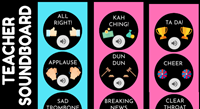While listening to Annie Forest’s vlog at
http://showyourthinkingmath.blogspot.com/2017/04/small-changes-that-make-big-impact.html
my life kinda flashed before my eyes!
As further background, Mrs. Forest is highlighting an excellent article, titled, “Never Say Anything a Kid Can Say!” Author: Reinhart, Steven C.; Source: Mathematics Teaching in the Middle School, v5 n8 p478-83 Apr 2000. The article is excellent!
The things I learned from my teachers and other teachers that I’ve been using (as a teacher) that I often don’t think about. I’ll make a short list here. This probably needs to be further developed at some point.
- My (late) college math professor, Dr. Mildred Gross, was a very caring person, but not exuberant. She was small, quiet, and reserved (collected and very organized). When you answered a question, she would often ask, “Why?” This is the neutral response (which Annie talks about in the vlog) — not telling the student that they are right or wrong.
- My cooperating teacher, when I student taught, was Mr. Pool. He had a rule of thumb: I like to call on every student every day, so that when they walk out of my classroom, they knew they were there for a reason. This has been a great rule of thumb.
- Someone told me (it may have been Melfried Olson) that the tutor should avoid picking up the pencil. The student should so all the writing. Good general rule.
- A Corollary to Never Say Anything a Kid Can Say! is “Never Punch into a Calculator Anything a Student Can Punch.” I’ve developed a rule of thumb for myself when it comes to calculations from a calculator. I do not even take a calculator to class. (If using Desmos, I do demo Desmos.)
In math class when we get down to a step that might require a calculator, here’s how it goes. (This happens an average of 4 times everyday.)
T: OK now we have 2.8x = 18.2
T: Do we have a mental math strategy for that? (3 second wait) I don’t think so. Please put that into a calculator. (3 second wait) Who has the answer? (BTW, as the S’s are punching keys, I’m doing a mental estimate 😉
S: 6.5
Then T looks around the room. If at least two other students (with calculators out) give a head-nod, T moves on. If there are no head nods, T asks, “Does 6.5 agree with the other calculators in the room?”
I use this strategy for the following reasons:
- Keep the students engaged. (I teach college. Sometimes students need to learn that learning is a participation sport.)
- It teaches that we should always ask the question Do we have a mental math strategy for that? (and I teach mental math and if was 2x = 18.2, we would have a strategy)
- Teach them to use a calculator – parentheses, logs, exponents, etc.
- If they can’t put it into a calculator, I’m loosing them and I never want to loose them.
- I do sometime walk around and peek into some calculator.
#HelpStudentsLearn

